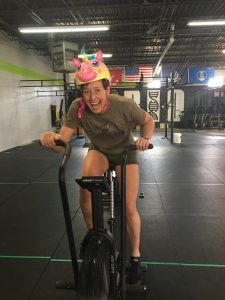Deconstruction of an Athlete
You have an athlete who wants to be awesome at skill X-Y-or Z than where they are currently. They get into the pool, run miles, practice movement patterns in the gym for hours each week trying to get faster and stronger (or to just perform the movement well).
The question isn’t that the athlete is working too hard (although this too may be an issue); it’s that the athlete or the coach isn’t really looking at the looking at where the weak spots are in their movement patterns, and where those patterns were created.
Let’s look at the case that was presented on the USAT Facebook page this past week. A 67 year old woman, former figure skater turned triathlete. She has fine tuned her swim to be able to average a 1:44 per 100, but she wants to get faster. This is a woman who still skates, so we’re going to have to assume that her core connection from her big toe to her head is spot on, and no nagging injuries from this one time sport of hers. She can still do single and double axels so this is a good indication that she most likely has great ability to connect in the water with her body. She knows how to move in space.
But what hasn’t been looked at is that she rotates most likely in the same direction. Very similarly to someone who plays baseball and always throws with one hand. Their ability to apply force using one side of their body is probably greater than the other side over the years.
In this case we would have to analyze which side is producing the most power. Can you unwind years of movement patterns? I believe you can quite a bit, although it takes time through unilateral strength training (while still training both sides of course).
Also not stated in this case is if the athlete does ANY strength training? We know she has great leg strength, but what about her lats? What about control of the scapula, and also the ability to apply the whole shoulder structure in force production? For someone who is over the age of 40 you can bet that this is probably the missing piece for her to get faster. Not swimming more.
Instead we had a lot of coaches throwing more sets and stroke technique advice. This would be valuable if we actually had a video of the swimmer, but we didn’t. So a lot of assumptions were being made.
Another case I’ve come across is an athlete who is working on his double unders. He’s got the connection with the arms, the rope is held well with the hands, and he can jump really well and in control. After watching him for awhile I could see where the weakness was in his kinetic chain (from head to toes). So I video taped him so he could look at it in slow motion and see where his stronger side was dominating once he got tired. In other words he started to lean towards his right side (he is right handed).
Whether you’re a figure skater or baseball player doesn’t matter for the most part because we all have a stronger more dominant side on our body. It doesn’t always show up until we are under load, and fatigue starts to set.
How does my double under person fix his issues? Most likely just being aware of it is the first step. Next he can start to strengthen the opposite side of his body (especially the hip/QL/Oblique region) and create a stiffer spine (or should I say more supported spine).
So if you have a movement pattern that has been bugging you, start asking yourself these questions:
- What side of my body gets injured more?
- What major trauma have I had in my life (physical and emotional, because they both affect how we move?
- Have I video-taped myself doing this movement?
- Am I aware of range of motion issues, and what side is the ‘better’ side?
- Have I done anything to correct it?
Deconstruct the movements to find a better result versus working harder. Why waste time and energy doing things over and over again with no improvement if you can go at it from a different perspective?

